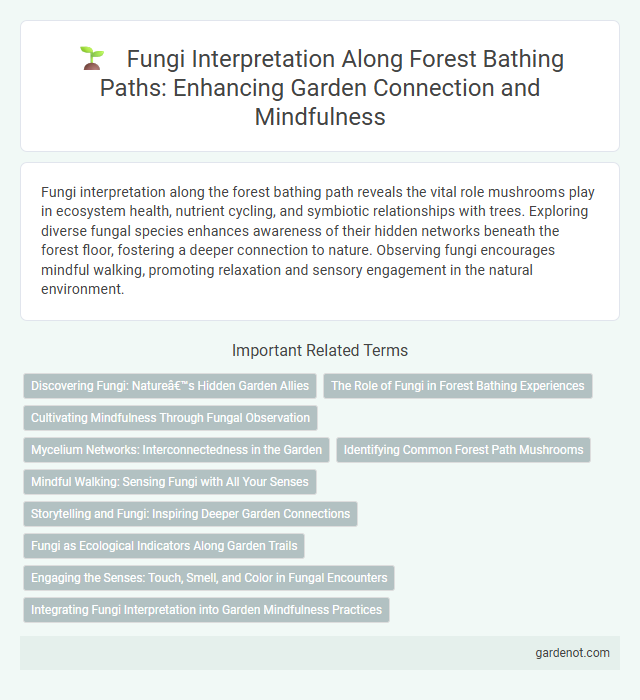Fungi interpretation along the forest bathing path reveals the vital role mushrooms play in ecosystem health, nutrient cycling, and symbiotic relationships with trees. Exploring diverse fungal species enhances awareness of their hidden networks beneath the forest floor, fostering a deeper connection to nature. Observing fungi encourages mindful walking, promoting relaxation and sensory engagement in the natural environment.
Discovering Fungi: Nature’s Hidden Garden Allies
Discovering fungi along a forest bathing path reveals their crucial role in ecosystem health and nutrient cycling. These hidden garden allies form symbiotic relationships with trees, enhancing nutrient absorption and soil fertility. Observing the diverse shapes and colors of mushrooms emphasizes the complexity and resilience of forest habitats.
The Role of Fungi in Forest Bathing Experiences
Fungi play a crucial role in forest bathing experiences by enhancing ecological awareness and deepening sensory connection to the forest environment. Through mycelium networks, fungi facilitate nutrient cycling and symbiotic relationships with trees, fostering a healthy forest ecosystem that visitors can observe and appreciate. Interpreting fungi during forest bathing enriches understanding of biodiversity, ecosystem health, and the hidden complexities sustaining woodland habitats.
Cultivating Mindfulness Through Fungal Observation
Observing fungi along the forest bathing path enhances mindfulness by encouraging slow, deliberate attention to natural details, such as varying textures, colors, and growth patterns of mushrooms and molds. Engaging with these fungal forms stimulates sensory awareness and fosters a deeper connection to the ecosystem's subtle rhythms. This practice supports mental clarity and present-moment focus, key aspects of mindfulness cultivated through ecological immersion.
Mycelium Networks: Interconnectedness in the Garden
Mycelium networks form an underground web connecting trees, plants, and fungi, facilitating nutrient exchange and communication within forest ecosystems. This symbiotic relationship enhances soil health and promotes biodiversity by linking organisms in complex, cooperative systems. Understanding these networks reveals the interconnectedness essential for sustaining a resilient and thriving garden environment.
Identifying Common Forest Path Mushrooms
Identifying common forest path mushrooms involves recognizing species such as the Fly Agaric (Amanita muscaria), Chanterelle (Cantharellus cibarius), and Oyster Mushroom (Pleurotus ostreatus), each characterized by distinct cap shapes and colors. Understanding the ecological roles of these fungi, including their symbiotic relationships with trees and contribution to nutrient cycling, enhances the forest bathing experience. Observing mushroom habitats and seasonal growth patterns provides valuable insights into forest biodiversity and ecosystem health.
Mindful Walking: Sensing Fungi with All Your Senses
Mindful walking along the forest bathing path encourages deep sensory engagement with fungi, from observing their vivid colors and intricate textures to inhaling earthy, damp aromas that connect you to the woodland environment. Touching the spongy caps and listening to the subtle sounds of rustling leaves enhance a heightened awareness of fungal life cycles and ecological roles. This immersive practice fosters a profound appreciation for the symbiotic relationships fungi maintain within forest ecosystems, promoting mental clarity and emotional well-being.
Storytelling and Fungi: Inspiring Deeper Garden Connections
Storytelling through fungi interpretation on forest bathing paths enriches visitor experiences by revealing the hidden ecological roles of mushrooms and molds. Narratives about mycelium networks and fungal symbiosis foster emotional connections and promote environmental stewardship within garden settings. This immersive approach transforms passive observation into meaningful engagement, inspiring deeper appreciation for forest ecosystems.
Fungi as Ecological Indicators Along Garden Trails
Fungi serve as vital ecological indicators along garden trails, reflecting soil health and biodiversity levels through their diverse species and growth patterns. Mycorrhizal fungi form symbiotic relationships with plants, enhancing nutrient exchange and signaling ecosystem stability. Monitoring fungal presence and diversity provides valuable insights into environmental changes and habitat quality within forest bathing paths.
Engaging the Senses: Touch, Smell, and Color in Fungal Encounters
Fungi on forest bathing paths captivate through their diverse textures, from velvety caps to rough stems, inviting tactile exploration that deepens sensory connection. Their earthy, musty aromas enhance the olfactory experience, grounding visitors in the natural environment. Vibrant colors, ranging from bright oranges to subtle whites, provide visual intrigue and highlight fungal biodiversity, enriching the immersive forest walk.
Integrating Fungi Interpretation into Garden Mindfulness Practices
Integrating fungi interpretation into garden mindfulness practices enhances sensory awareness and deepens ecological connection by highlighting the vital roles fungi play in forest ecosystems, such as nutrient cycling and symbiotic relationships with plants. Observing diverse fungal species along a forest bathing path encourages mindful observation and fosters appreciation for biodiversity, promoting mental well-being and environmental stewardship. Educational signage and guided meditations centered on fungal life cycles enrich the mindfulness experience by blending scientific insight with sensory engagement.
fungi interpretation Infographic

 gardenot.com
gardenot.com